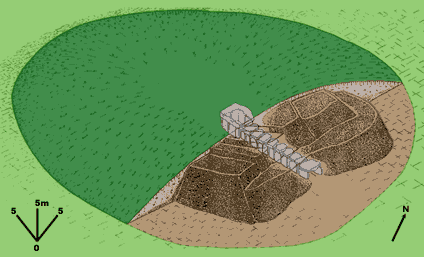- Home
- Discover the megaliths of Morbihan
- Monumentalism
- Civilisations and megaliths
- Attempting to understand megaliths
- Cairns and mounds
Sealed tombs ("tumulated tombs")
"Open" tombs ("dolmenic" tombs)
Unlike the tumuli, they consist of a system linking them to the outside world (a passage, a vestibule, an antechamber, and a door). Death is therefore seen in a different perspective. Bone remains often correspond to secondary deposits, showing a certain interaction between the living and the dead (or between the living and the relics materialising the memory of the dead).
The relative sizes of the chamber and of the entrance passages show that the dead had to be left in peace, relatively speaking, even though the living could be in contact with them (two extreme instances of this are the long-passage Middle Neolithic tombs and the Late Neolithic gallery graves ).
The subdivisions of the chamber seem to indicate that funerary functions could be differenciated.
All types of Late Neolithic gallery-type tombs have extended chambers and smaller access structures as well as greatly reduced external structures. All that goes hand in hand with a change in funerary technique (i.e. more bodies but more individual treatment), which became the main reason for the existence of these tombs.
Art in megalithic tombs
This kind of art illustrates the complexity of the sacred in Neolithic times. It is all the more difficult to study since many of the decorated slabs were reused in later monuments and buildings.
Rock art is almost unknown inside "sealed" tombs, which were not designed to provide access to the living, but a few examples can be seen on menhirs.
Two main cycles can be found:
- the first, in the 5th and 4th millennia, evolved local styles typical of Gavrinis or Pierres-Plates;
- the second, in the 3rd millennium, can be related to Late Neolithic gallery-type tombs.
Exploded view of Gavrinis showing the small size of the chamber and the long passage leading to it at the heart of a square-shaped cairn covered with a rounded barrow.

